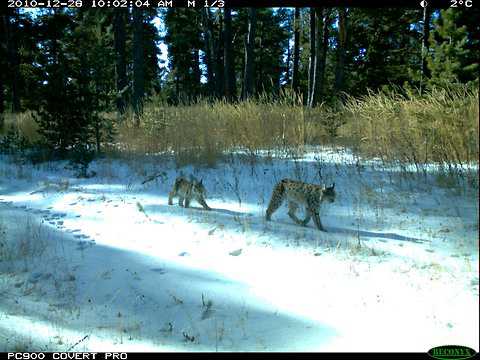By JIM ROBBINS
 A
A
A lynx with its kitten, photographed last winter by a camera trap in Kars Sarikamis-Allahuekber National Park in Turkey.KuzeyDoga
A new paper by biologists in Turkey and the United States warns that while Turkey’s rich biodiversity is unique and globally important, it remains poorly researched and faces growing threats, especially from development.
In the paper, published in the journal Biological Conservation, the 13 authors say they hope to alert the world to the intensity of the assault on the country’s biodiversity. “It’s worse than at any time in Turkey’s history,” said Cagan Sekercioglu, an assistant professor of biology at the University of Utah and the paper’s lead author.
Of 34 places in the world identified as biodiversity hot spots — places where the diversity of life is unusually rich – Turkey is the only country covered almost in its entirety by three of these regions. A big reason is simply that it has coastlines on four seas, and four major mountain ranges.
Of some 9,000 known species of vascular plants, 3,000 are found only in Turkey. A new plant species is found there once a week on the average scientists say, and its array of reptile and amphibian species is comparable to that of all of Europe. New mammals are even being identified, among them a mountain gazelle discovered in 2009.
That such a large species went unidentified for so long reflects a lack of research and documentation, the scientists write. Yet its uniqueness was not widely appreciated. “The population of this vulnerable species became threatened within only a year of its discovery by the planned construction of a cement plant in its small range,” the paper states.
One reason that Turkey’s natural treasures are poorly studied is cultural, Dr. Sekercioglu said. While scientists in the United States and Europe do research in the field for weeks and months at a time, that is not the custom in Turkey, where professors seldom leave the classroom. What is more, he said, Turkey is not developed enough to pay proper attention to its own biodiversity, or “charismatic” enough to capture the imagination of international organizations that cast a spotlight on threatened ecosystems.
Dr. Sekercioglu is trying to change this through a nonprofit called KuzeyDoga that works to promote biodiversity research and conservation in Turkey.
Even as Turkey begins to grasp and study the wealth of its natural life, Dr. Sekercioglu says, it is receding in the face of inexorable development pressures, from dams to vacation homes. While environmental laws exist, they are often modified when they get in the way of projects, he added.
The paper also cites the case of a professor who was investigating heavy metals from mining found in the breast milk and feces of infants. The professor, Onur Hamzaoglu, was sued by local mayors and faces a two- to four-year jail term for ‘threatening to incite fear and panic among the population,’’ the authors write.
The biologists call on the country to foster a culture of conservation that they say has been sorely lacking. One way of achieving this may be to tie environmental concerns to Turkey’s history, a source of national pride, they suggest.
“Instead of beginning a dialogue on large predator conservation by describing ecological interactions,” the paper says, “one could describe the Roman-era stone traps for Anatolian tigers and leopards still visible in the Toros Mountains.”
This post has been revised to reflect the following correction:
Correction: December 22, 2011
An earlier version of this post misstated the number of seas bordered by Turkey. It borders four, not three.
via Biodiversity in Turkey, at Risk Yet Largely Ignored – NYTimes.com.

Leave a Reply